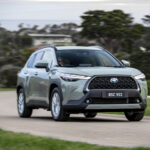By EWAN KENNEDY
CAPTIONS: A.
B.
C. 2002 Toyota Celica
BODY COPY
Toyota Celica was a big seller in the sporty coupe market for many years. It fell out of fashion, along with rivals which had never really come close to it in the sales race. Celica was quietly slipped from the new-car market in early in 2006. But is still popular on the used-car scene. Even more so since the release of the Toyota 86 and its near-identical twin the Subaru BRZ.
The launch of the fourth generation Mazda MX-5 a few months ago has also put a real spark back into sports models and the used values of the Celica may reflect this. Buy one now and it may not drop a lot in depreciation, no promises, though.
Toyota Celica is well-built and is well know for reliability if looked after properly and driven sensibly. Under the sleek skin there’s a relatively simple design sharing many of its components with other cars in the huge Toyota range.
The final iteration of the Celica range, introduced in November 2000, is more of a true sports machine than its predecessors, which were cafe cruisers rather than on-road bruisers. On the other hand the post-2000 model is almost too sporty for those who do like to potter along, it has to be driven at least moderately hard or it can feel like a bit of a dog at times.
Celica is sold as a two-door coupe and a three-door hatchback (‘Liftback’ in Toyota speak). The liftback is surprisingly practical for a car of its type and appeals to single or couples who have one as their sole machine.
Rear seat room is more suited to small children than to teenagers or adults. Get the kids to try the back seat during your road test. And make sure they check it for outwards visibility.
Handling in the older models is reasonably good and will usually please all but the hardest drivers. The 2000 Celica is much sharper on the road, with quick turn in and good feedback through the steering. It achieves this with little loss in ride comfort compared with the previous generation cars.
In the standard Celica the engine was a 2.2-litre unit until the size dropped to 1.8 litres with the year 2000 model, the latter carrying a lot of high-tech features to lift its power to considerably more than the older engine.
The downside of the 1.8-litre is that you don’t get a great deal of power or torque at lower engine speeds so you have to work at keeping it on the boil. Which is fine for the keen driver but those simply looking for a visually attractive car may find it all a bit much after a while.
The turbocharged rally-based Toyota Celica GT-Four is a hot performer, and is far more expensive than the rest of the range. It was sold from 1990 to 1992, then again in a limited production run in 1994 as the GT-Four Group A Rallye. The latter is a full-on sports machine. The Celica GT-Four 2.0-litre turbocharged engine is happiest when worked hard and turbo lag can be frustrating at times.
Transmission options are five-speed manual and four-speed automatic in the standard models. The hot GT-Four comes only as a five-speed manual.
There are Toyota dealers in just about any area of significance within Australia, but not many in the remote bush will carry parts for Celicas. Parts are generally reasonably priced.
Celica repairs are relatively easy for the home mechanic, but please leave the safety items to qualified people. Celica GT-Four should be left to professionals as it’s a very specialised machine.
Insurance on the standard Toyota Celica is relatively low (for a sports coupe, that is) but the GT-Four will cost big dollars to insure because of its turbo engine and sporting nature.
WHAT TO LOOK FOR
Rust is uncommon, but check in the lower edges of the doors and the hatch/bootlid, the lower-rear corners of the mudguards, the door sills, the floor of the boot and around the fuel filler cover.
Check that the engine starts promptly, idles smoothly, accelerates without hesitation and doesn’t smoke from the exhaust tailpipe when worked hard.
If the gearchange in a manual car is sloppy or too tight there could be problems. During the test drive do a couple of fast downchanges from third to second and feel for baulking and listen for crunching. Both indicate an overhaul is due, though it may only be a clutch adjustment problem.
Automatics that are slow to go into Drive or Reverse from Neutral or Park may be worn out. Also feel for harsh changes and for changes which probably weren’t necessary.
Make sure the brakes operate without too much effort and pull the car up cleanly without one wheel locking before the others. If ABS is fitted you should feel for a pulsing through the brake pedal on very hard applications.
Feel for a car which wanders to one side during your test drive. It may have been incorrectly repaired after a crash, or it could have front wheel alignment problems.
DDDD A Toyota Celica GT-Four which has been raced or rallied could have expensive troubles looming. Look for a roll cage, racing harnesses, navigation aids, a strengthened body shell and big wheels and tyres.
CAR BUYING TIP
Few sporty machine are ever driven in a sporty manner, those which have been hammered should either be ignored, or carry a low price tag.














